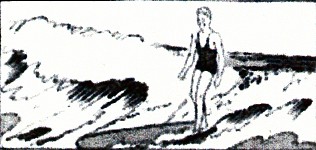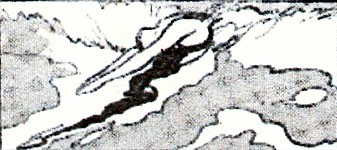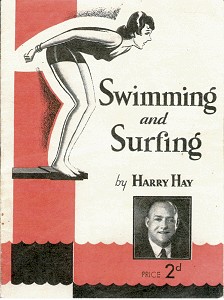 |
surfresearch.com.au
harry hay : surfriding, 1931 |
| home | catalogue | history | references | appendix |
|
A pdf. copy of this book contributed,
with thanks, by Henry Marfleet, January 2008.
| Page 9
Surf Board Riding |
 |
The "roller" wave
is mostly to be had at high tide.
The "dumper"
is more frequenty at low tide - though this is not a hard and fast rule.
The "roller" or
"slide' is the wave to be ridden.
The "dumper"
must be avoided.
It is dangerous,
but can be picked up safely by an expert in the art of "broaching".
Broaching means turning the surf board sideways and parallel to the wave, at the same time sliding down the crest - keeping the near side of the board down and the far side slightly tilted to prevent dipping.
As a begtinner
you are advised to start at surf board riding by going into waist deep
water where the waves are broken.
Take up a standing
position at the back of the board, which should be facing nose shorewards.
As the wave approaches,
push off and forward, allowing the body to rest on the board, lower leg
and feet trailing in the water behind.
In this manner,
the board is fairly balanced and the force of the wave carries you into
shore.
When you can balance
and guide the board on broken wave, the next thing is to learn how to paddle.
This is necessary
in order that you may reach unbroken waves in deep water.
Lie flat out
on the board, body fully extended, feet overhanging the end of the board,
arms straight out in front in the water at the sides of the board.
Now pull the arm
under water to a position in line with the hips.
When the arms
reach this positlon, pick them out of the water, bend them at the elbows
and carry the arms underneath and forward to the straight out position
in front and at the sides of the board.
Page 10
When you become
expert at this very necessary part of the art, paddle your board out to
the unbroken wave.
It is now that the art of broaching will be found most useful, and the rider is advised to broach the wave immediately he feels its force carrying him forward.
When the slide has been negotiated, the wave will begin to flatten out, and you can then straighten the board and enjoy the ride to the shore.
Up to this point
you have been lying on the board.
Personal experience
will enable you to judge when you are ready to try standing up.
Go out to the
unbroken wave once more.
Select your wave.
Start paddling
and let the wave pick you up, broach the wave, negotiate the slide. straighten
the board out.
Now take firm
hold with the hands at the sides of the board half-way down.
At the same time
lift the head and chest, draw one leg after the other and place the feet
on the board, resting on your haunches three parts of the way back on the
board and in the centre - feet slightly apart.
Be careful not
to overbalance or lose the grip with the hands.
Keep the eyes
in the direction you are going and guide the board by distribution of weight.
Now that you can stand up on the board you must learn to guide the board with your feet.
One foot is placed
forward slightly to the side of the board - the other remains behind and
slightly to the opposite side of the board.
Be careful not
to place the feet too far apart.
Now use the weight
for guiding purposes by shifting from one foot to the other as the direction
requIres.
Look straight
ahead and not down at the feet.
A sense of balance
will bring the feet into their right position with plenty of practice.
A standard surf
board should measure approximately nine feet long and twenty four inches
in width-across the middle.
The middle of
the board should be three inches in depth; should taper to one and three
quarter inches at the base; and to one inch at the nose.
| Page 11
Surf Shooting |
 |
That wave ought
to have taken you quite a lot further than the previous ones because you
started off with the wave at its full force.
In the previous
attempts each wave was partly spent.
Practice this
a number of times until you feel that you are getting some distance out
of the waves.
The "dumper" is
the wave you have to avoid.
It is picked
out by the experienced surfer as the big hollow wave without any gliding
water.
It simply mounts
up to its full height, turns over and comes straight down wIth a dtep boom,
churning everything over and over in its course.
It stirs the
sand up and generally makes surfing uncomfortable.
Dumpers can be
negoriated by experienced surfers in deep water and when they are not too
tremendous.
After you have
mastered much of the art of surf shooting, you can try holdng your head
and taking a breath or two as the wave carries you forward.
Then you can
try keeping your head up all the way.
To ride in with
your head up it will be necessary for you to relax the body more and to
arch the back so that you will keep the trunk of the body in the wave.
Page 12
The next thing
to do is shoot the wave with your arms by your sides.
Take the wave
as you have been doing previously.
When you are
fairly on it, draw your arms round and backward until they reach your thighs.
Hold them there
in a relaxed position and let the wave take you shorewards.
When you have
done this a number of times bring your arms to the sides immediately you
take the wave.
You will probably
find this a bit awkward at first.
But practise
it hard and it won't be long before you will do it correctly.
The movements
of the head can now be brought into play.
You will sometimes
find that the wave is dropping you a little.
When this happens
dip your head forward so that your face is under water.
Remain in that
position until you feel the wave carrying you once again.
Then lift your
head and take a breath.
Constant use
of the head in this manner will help you to arrive at perfect balance,
which, when you have it correctly, allows you to ride all the way in with
your head up.
Now try picking
up a wave in deepwater.
Here you cannot
push off bottom as you have been doing previously.
The thing to
do now is use your own judgment as to when you think the wave is going
to break.
See that you
give yourself time enough to swim two or three powerful strokes.
As you feel yourself
being lifted by the wave make your last effort or stroke.
Then quickly
get into position to shoot - hands to the thighs, relaxed.
Take a deep breath,
head not too high, body straight, but not stiff.
When you once
catch a wave in this manner the thrill of it will take you back a thousand
times, and soon you will be expert at it.
You can then
do some expert shooting.
For instance
- instead of swimming to pick up the wave, wait for it to come to you and,
as you are being lifted, swing the body round and forward.
If you have timed
this movement correctly, the wave will do the rest.
If, when a wave
is dropping you, you feel you are going to come out of the back of it -
try lifting one leg from the knee up out of the water.
Bend the knee
so that the foot and foreleg come clean out of the water - you will find
that this has thrown the weight forward and allowed the force of the wave
under the body - so that your body will race along and catch up with the
front
of the wave again.
|
Hay, Harry.: Swimming and Surfing. Jantzen (Australia) Ltd, Lidcome, Sydney, 1931. Pages 9 to 12. A pdf. copy of this book contributed,
|
 |

| home | catalogue | history | references | appendix |